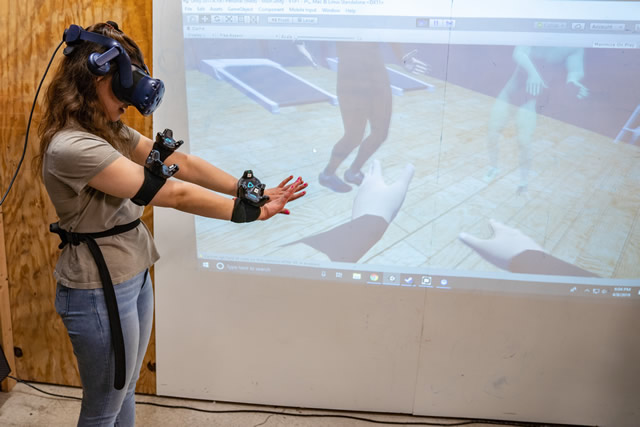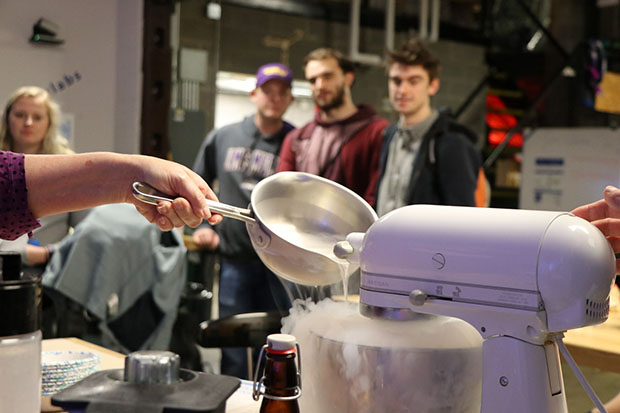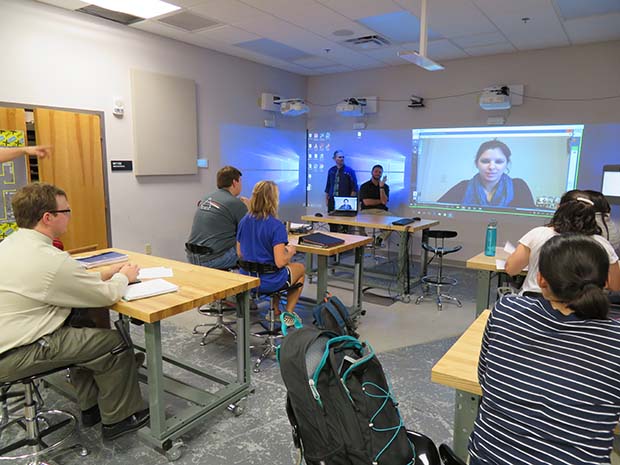Reinventing the Student Experience
At a time when higher education
is trying to keep pace with the rapidly
changing needs of industry, it is increasingly
important to provide students with skills
that go beyond traditional expectations.
Makerspaces—labs designed for students to
get hands-on experience creating projects—are becoming a popular way to help students
create and provide experience with tools
they will use in the world of work.

Photo Courtesy of JMU X-Labs
THE RISE OF MAKERSPACES
In the past, the student experience in college
consisted primarily of large lecture halls
or smaller classrooms where students sat in
rows of desks while the instructor imparted
the lesson. While this approach covers content
material, the content sticks better when
students are engaged in it. This is where
project-based learning and makerspaces
come in. Projects engage students in ways
that traditional lectures don’t because when
students are working on a project—solving
a real-world problem—they have no choice
but to immerse themselves in the content.
As the Maker Movement has taken hold
over the past decade or so, more and more
colleges and universities—as well as K–12
institutions—have created makerspaces to
provide a location, materials, and resources
to promote this type of active learning for
STEM courses. A great example is JMU
X-Labs at James Madison University in
Harrisonburg, VA.
JMU X-Labs utilizes an active-learning
classroom and makerspace created to bring
students from multiple disciplines together
to work on hands-on, real-world projects.
The university partners with outside
organizations to develop the projects and
students work in teams using technology to
come up with potential solutions. Projects
may involve designing autonomous vehicles
or drones to perform specific tasks,
or using VR technology to practice surgery
skills. Courses have titles such as “Augmented/Virtual Reality,” “Blockchain,”
“Medical Innovations,” and “Hacking for
Diplomacy.” The lab also houses makerspace
equipment such as vinyl cutters, 3D
printers, and Epson interactive displays
for various types of projects. It also hosts
“pop-up” classes on topics ranging from
laser-cut jewelry to liquid nitrogen ice
cream.
In order to create a great makerspace
that truly re-invents the student experience
from a “sit and get” approach to an
engaging, immersive learning experience,
it’s important to focus on three key
components: outside partners; effective
technology; and curriculum that’s designed
for collaboration.

Photo Courtesy of JMU X-Labs
OUTSIDE PARTNERS
There is no better way to prepare students
for the workforce than to allow them
opportunities while in college to partner
with businesses, governments, or nonprofit
organizations. JMU X-Labs enlists outside
partners—organizations like the Smithsonian
Conservation Biology Institute and
Endgame, a cybersecurity firm—to come
up with a list of six to eight problems for
students to work on. The instructors and
the organizations don’t know what the
solutions are. The students are divided into
multidisciplinary teams and turned loose
to work on developing a solution. They
conduct interviews and present every week
to provide an update on their project. The
business partners typically join via video
conferencing to watch the presentations
and provide feedback. Students can use
technology to talk to the partners during
the week and then they develop prototypes
based on their feedback.
This collaboration with outside partners
is incredibly helpful because students
get experience interacting with and
presenting to potential employers. Some
students have gone on to get hired at the
companies that they collaborated with at
JMU X-Labs.
TRANSPARENT, EFFECTIVE TECHNOLOGY
In a makerspace atmosphere, technology
should be transparent. In other words,
it should be easy to use and should enhance
and facilitate learning without becoming a focal point itself. JMU X-Labs features five
interactive laser displays. Students can work
in groups on their projects and project their
work directly onto a wall and then annotate
directly on that image using their fingers.
For example, they can project a map or a
graph onto the wall and circle points of interest
or certain data points and make notes
about what those represent. The lab also
has the capability of creating a video wall
in which four of the Epson displays project
onto a wall to create a single, large, seamless
image that runs the entire length of the wall.
This is helpful in the VR classes. If a student
is trying to show the glitches in a virtual reality
program, the student wears the VR headset
and projects what they are seeing onto the
large video wall so the rest of the class can see
it. Then the student goes through the VR program
and points out the glitches. The large
image makes it easy for the rest of the class to
spot the problems. They can then collaborate
on how to fix them.
For videoconferencing, JMU X-Labs uses
Cisco solutions and the Epson displays. The
lab is equipped with cameras in the front
and back of the room so if a business partner
or an instructor is conferencing in, they
can alternate between views of a student
who is presenting at the front of the room
and the students in the back who might ask
questions or weigh in on the presentation.
The lab also has a Beam telepresence robot
that can move around and interact with
people. In some situations, the person who
is videoconferencing in takes control of the
robot and uses it to virtually move around
the room and “talk” to students.

Photo Courtesy of JMU X-Labs
COURSES DESIGNED FOR COLLABORATION
JMU X-Labs goes beyond teaching a
student about engineering or coding. It
teaches teamwork, collaboration, presentation
skills, and how to work with outside
industries to solve real-world problems.
The lab works because courses are
designed to be truly collaborative, which
transforms the student experience from
one based on memorizing facts and content
to getting actual experience in doing the
work—including working with a group to
figure out a solution.
All students have a role. For example,
in some of the courses, students designed
drones to do specific jobs such as
inoculating a herd of animals in the wild or
mapping the route of a stream to identify
areas of pollution and erosion. Students
work in teams to create the designs and
prototypes. Teams could consist of students
majoring in everything from engineering
and physics to biology and English. They
all play a role. One might lead the research
while another leads the design process.
Another might be in charge of creating a
video or paper to document the process.
Working together, all students have a role in
all parts of the project.
When done right, courses will teach
students skills that bring them out
of their comfort zone. A student may
be great at physics, but not so great at
communicating with others. The courses
that JMU X-Labs designs require students
to conduct research and talk to experts
on the phone to get input and advice to
solve a problem. Students must figure
out how to frame their questions and
articulate them to the expert clearly and
concisely in a way that makes the expert
want to help them. These skills will help
students down the road; for example, as
they ask their department for funding or
apply for a grant, they’ll be able to clearly
articulate their need in a persuasive and
professional manner.
Creating a high-tech makerspace at a
college or university is worth the investment.
The institution just needs to make
sure it’s done right. If they can bring in
outside partners, equip the space with the
right technology, and develop truly collaborative
courses, it will be an amazing asset
to both the institution and its students.
It will draw students to enroll and will
teach them skills that will both help them
get hired and prepare them to take on the
future challenges of the world—which is a
win for everyone.
This article originally appeared in the College Planning & Management October 2019 issue of Spaces4Learning.